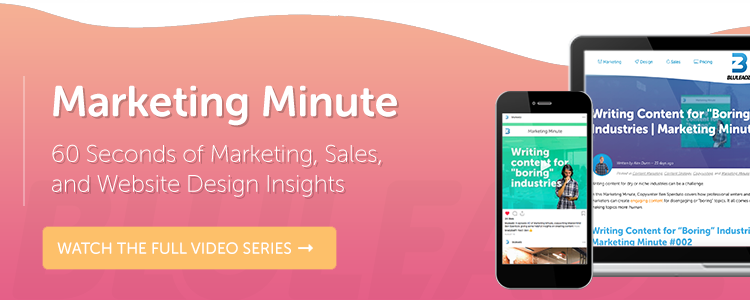Inbound marketing, and the agencies that practice and preach it, have come a long way since the early days of HubSpot. In fact, in just the past two years, there have been dramatic changes in how companies use inbound to engage with visitors and create brand evangelists.
The relationship between sales and marketing has shifted, priorities have changed, and an influx of data tools, new technologies, and apps have changed how businesses define and measure success.
Here's a quote from Brian Brady of the Bluleadz Marketing Team:
Hi guys, my name is Brian Brady. I'm one of the Inbound Marketing Consultants here at Bluleadz, and today on the Marketing Minute, we want to talk to you about where inbound marketing has come from and where it's going in the future.
Toda y, inbound marketing has become about education. Educating the leads that come to your website to turn them into qualified opportunities, that you can turn over to your sales team. Another shift in the way we do inbound is data; no longer can we rely on a 12-month annual plan to get us through—we have to be agile.Clients look to us to analyze data on a weekly, monthly, and quarterly basis. The reason to continuously focus on your data is to recognize what is and isn't working. That allows you to make adjustments on the fly.
Another shift we've seen in the marketing world is technology. New apps and integrations allow you to automate the process of identifying what content to send to the right people at the right time.
Education as a Driving Force
Perhaps the most significant change inbound brought to the marketing space is the focus on education over pure sales and awareness.
This has always been a core component of inbound, but it’s really become the primary focus just recently. Mentalities have shifted, both among marketers and the audiences they’re trying to reach.
Today, all buyers are informed buyers; selling to potential buyers isn’t enough anymore. Rather, giving buyers the available information to identify solutions or benefits of our product/service, and leading them along to make their own purchasing decision, is the name of the game—especially for B2B opportunities.
Bridging the Sales and Marketing Divide
Another huge change in the inbound space deals with the split between sales and marketing, or rather, the lack thereof.
We’re now at a place where any problematic divide between the two is due to “user error,” so to speak. The automated tools, methodologies and structures are out in the open to help businesses eliminate the gap altogether.
Take HubSpot’s CRM, for instance. With proper segmentation and expectations set up between sales and marketing, there’s no reason for there to be significant hiccups in the hand-off between both teams. The companies that still experience disruptions are those without clear communication between the teams; communication that establishes:
- What defines a MQL and SQL—and more importantly, where the line is drawn between each.
- Goals and capabilities of the service team—the implementers, service providers or company partners that provide the deliverable(s). This is where introducing a Service Level Agreement (SLA) between the teams can be crucial.
- Expectations for the service team—this involves including implementers in the inbound sales process. In the case of marketing agencies, for example, this may involve including a strategist or content creator in initial conversations (“discovery calls”) to both learn about the client and assess their compatibility.
Data and Technology
The final significant change in inbound relates to the new apps, analytics tools, and technologies that marketers have at their disposal.
For the most part, these new tools are developed with customer expectations in mind, and to help marketers meet those expectations. Marketers need tools that allow them to provide ROI on a frequent basis. Savvy B2B clients want to see results in real-time, whether that’s in monthly, weekly, or even daily numbers.
However, these tools also benefits marketers. It allows agencies or in-house team members to determine what efforts are worthwhile and what initiatives they should pull the plug on to reallocate resources.
Companies aren’t locked in with 6- or 12-month marketing plans. New data has made it possible for companies to truly be agile.
New technologies and data-driven marketing are a win-win for marketers and their clients. Marketers can make changes on the fly to focus what works, and clients can see with near immediacy how any aspect of their marketing is performing.
Inbound is, fundamentally, in a constant state of change. Customers change, and so should marketers if they hope to keep up.


Alex Dunn
Alex is a University of South Florida mass communications graduate and Video/Media Specialist at Bluleadz. He is a big movie nerd, loves (possibly dangerous) concerts and enjoys taunting co-workers with a camera. He's probably seen The Royal Tenenbaums 14 times by now.